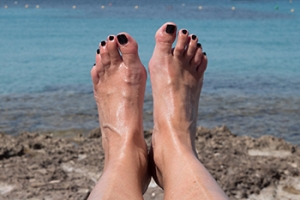Connect With Us
Super User
High Heels Can Lead to Morton’s Neuroma
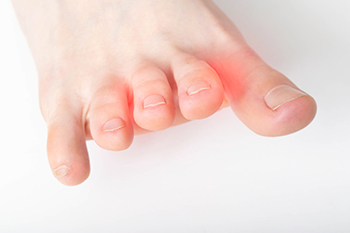
Morton’s neuroma is a painful foot condition that affects women more than men. It may develop from frequently wearing high heels and occurs in the nerve between the third and fourth toes. Many high heels do not have adequate room for the toes to move freely in and this can cause the nerve to become compressed. Common symptoms associated with Morton’s neuroma can include the sensation of stepping on a pebble or marble, numbness, or stabbing pain surrounding the affected area. Relief may be found when the foot is elevated and when soft insoles are worn inside the shoe. Patients who are overweight are encouraged to lose any additional weight to help reduce the pressure on the feet. It is also suggested to refrain from participating in running and jumping activities, and this may help accelerate the healing process. In severe cases, surgery may be required to permanently repair or remove the affected nerve for maximum comfort. If you have this foot condition, please consult a podiatrist who can effectively diagnose and treat Morton’s neuroma.
Morton’s neuroma is a very uncomfortable condition to live with. If you think you have Morton’s neuroma, contact one of our podiatrists of Boca Raton Podiatry . Our doctors will attend to all of your foot care needs and answer any of your related questions.
Morton’s Neuroma
Morton's neuroma is a painful foot condition that commonly affects the areas between the second and third or third and fourth toe, although other areas of the foot are also susceptible. Morton’s neuroma is caused by an inflamed nerve in the foot that is being squeezed and aggravated by surrounding bones.
What Increases the Chances of Having Morton’s Neuroma?
- Ill-fitting high heels or shoes that add pressure to the toe or foot
- Jogging, running or any sport that involves constant impact to the foot
- Flat feet, bunions, and any other foot deformities
Morton’s neuroma is a very treatable condition. Orthotics and shoe inserts can often be used to alleviate the pain on the forefront of the feet. In more severe cases, corticosteroids can also be prescribed. In order to figure out the best treatment for your neuroma, it’s recommended to seek the care of a podiatrist who can diagnose your condition and provide different treatment options.
If you have any questions, please feel free to contact our office located in Boca Raton, FL . We offer the newest diagnostic and treatment technologies for all your foot care needs.
What is Morton's Neuroma?
Morton’s neuroma, (also referred to as Morton’s metatarsalgia, Morton’s neuralgia, plantar neuroma or intermetatarsal neuroma) is a condition that is caused when the tissue around one of the nerves between your toes begins to thicken. This thickening can result in pain in the ball of the foot. Fortunately, the condition itself is not cancerous.
Morton’s neuroma affects women more often than men with a ratio of 4:1. It tends to target women between the age of 50 and 60, but it can occur in people of all ages. There are some risk factors that may put you at a slightly higher risk of developing the condition. People who often wear narrow or high-heeled shoes are often found to be linked to Morton’s neuroma. Additionally, activities such as running or jogging can put an enormous amount of pressure on the ligament and cause the nerve to thicken.
There usually aren’t any outward symptoms of this condition. A person who has Morton’s neuroma may feel as if they are standing on a pebble in their shoe. They may also feel a tingling or numbness in the toes as well as a burning pain in the ball of their foot that may radiate to their toes.
In order to properly diagnose you, the doctor will press on your foot to feel for a mass or tender spot. He may also do a series of tests such as x-rays, an ultrasound, or an MRI. X-rays are usually done to rule out any other causes for your foot pain such as a stress fracture. Ultrasounds are used to reveal soft tissue abnormalities that may exist, such as neuromas. Your podiatrist may want to use an MRI in order to visualize your soft tissues.
There are three main options for treatment of Morton’s neuroma: Injections, decompression surgery, and removal of the nerve. Injections of steroids into the painful area have been proven to help those with Morton’s neuroma. Decompression surgery has been shown to relieve pressure on the affected nerve by cutting nearby structures such as the ligaments in the foot. Another treatment option would be to surgically remove the growth to provide pain relief.
If you suspect that you have Morton’s neuroma you should make an appointment with your podiatrist right away. You shouldn’t ignore any foot pain that lasts longer than a few days, especially if the pain does not improve.
Best Shoes for People With Heel Spurs

Heel spurs are small, bony growths caused by excessive calcium deposits forming on the heel of the foot. These can grow on the bottom of the heel or the heel bone where the plantar fascia ligament attaches the heel to the toes. This connective tissue keeps the foot in a comfortable arch position, but a heel spur can damage the fibrous tissue and it will not be able to perform its job. In addition to causing every step one takes to be painful, heel spurs can cause long-term foot problems. Trying to purchase shoes that accommodate heel spurs can be an overwhelming task, yet it is imperative to wear proper footwear. When choosing footwear to alleviate pain and prevent further damage from heel spurs, it is crucial to look for shoes with firm rearfoots or backs of shoes. These are less apt to bend during movement and thus provide more support to the heel. Shoes should also have additional cushioning and a flexible forefoot that bends and stretches easily with movement. If you suffer from heel spurs, consult with a podiatrist who can help you with treating this condition, as well as suggest the best footwear to help with pain and prevention.
Heel spurs can be incredibly painful and sometimes may make you unable to participate in physical activities. To get medical care for your heel spurs, contact one of our podiatrists from Boca Raton Podiatry . Our doctors will do everything possible to treat your condition.
Heels Spurs
Heel spurs are formed by calcium deposits on the back of the foot where the heel is. This can also be caused by small fragments of bone breaking off one section of the foot, attaching onto the back of the foot. Heel spurs can also be bone growth on the back of the foot and may grow in the direction of the arch of the foot.
Older individuals usually suffer from heel spurs and pain sometimes intensifies with age. One of the main condition's spurs are related to is plantar fasciitis.
Pain
The pain associated with spurs is often because of weight placed on the feet. When someone is walking, their entire weight is concentrated on the feet. Bone spurs then have the tendency to affect other bones and tissues around the foot. As the pain continues, the feet will become tender and sensitive over time.
Treatments
There are many ways to treat heel spurs. If one is suffering from heel spurs in conjunction with pain, there are several methods for healing. Medication, surgery, and herbal care are some options.
If you have any questions feel free to contact our office located in Boca Raton, FL . We offer the latest in diagnostic and treatment technology to meet your needs.
Obesity and Plantar Fasciitis
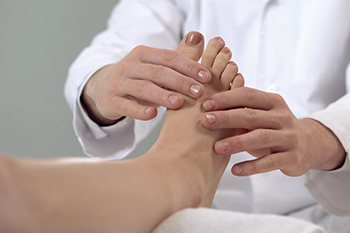
There are medical conditions that can arise from being obese. Plantar fasciitis is one such ailment that affects the heel and arch of the foot. The band of tissue that runs along the soles is called the plantar fascia and can become strained from enduring additional weight. The feet are the foundation of the body, and it is wise to lose weight to help reduce stress on the plantar fascia. Plantar fasciitis is a foot condition that can happen when the plantar fascia becomes inflamed which may cause severe pain and discomfort. People who are obese may find it helpful to spend extra time in choosing shoes that can accommodate their feet. Shoes that have a good arch support and a slightly raised heel are best to help prevent plantar fasciitis from developing. Wearing custom-made orthotics may be an option to further reduce existing tension on the plantar fascia. If you are overweight and would like to know how to protect your feet, please consult with a podiatrist who can offer you weight management advice in addition to tips on how to protect your feet.
Obesity has become very problematic at this point in time and can have extremely negative effects on the feet. If you’re an obese individual and are concerned about your feet, contact one of our podiatrists from Boca Raton Podiatry . Our doctors can provide the care you need to keep you pain-free and on your feet.
Obesity and Your Feet
Since your feet are what support your entire weight when standing, any additional weight can result in pain and swelling. Being overweight is one of the main contributors to foot complications.
Problems & Complications
Extra Weight – Even putting on just a few extra pounds could create serious complications for your feet. As your weight increases, your balance and body will shift, creating new stresses on your feet. This uneven weight distribution can cause pain, even while doing the simplest tasks, such as walking.
Diabetes – People who are overweight are at serious risk of developing type-2 diabetes, which has a drastic impact on the health of your feet. As you get older, your diabetes might worsen, which could lead to loss of feeling in your feet, sores, and bruises. You could also become more prone to various infections.
Plantar fasciitis – Pressure and stress that is placed on muscles, joints, and tendons can trigger plantar fasciitis, which is an inflammation of tissue that forms along the bottom of the foot.
If you have any questions please feel free to contact our office located in Boca Raton, FL . We offer the newest diagnostic and treatment technologies for all your foot and ankle needs.
How Obesity Affects Your Feet
Gaining weight can happen suddenly and at any time. Usually you won’t notice the extra weight until your feet start hurting at the end of the day. This happens as your feet begin adjusting to carrying more weight. Foot swelling and pain are two of the biggest side effects of having gained weight.
Many foot-related problems can occur even after just putting on a few pounds. This includes the body ‘compensating’ by changing the way it moves. You may find yourself putting extra weight on the wrong parts of your feet and even leaning forward a bit. Your feet were designed to carry a healthy, normal body weight. Extra weight places undue stress on them.
Being overweight often causes the development of Type-2 diabetes, causing leg and foot pain. Older people who do not attempt to control their condition can even lose sensation and feeling in their legs and feet. This can lead to the development of small sores that can lead to serious infection.
Extra stress placed on the joints, tendons and muscles in the feet as a result of extra body weight may also cause heel spurs, or plantar fasciitis. Plantar fasciitis is an inflammation of the foot tissue, causing stiffness and pain when walking and climbing stairs. This can usually be relieved by foot stretches and custom made orthotic shoe-inserts.
Problems in the feet triggered by obesity can be treated by paying special attention to footwear. Proper support shoes that allow for good circulation, especially in the arch and ankle, are vital. A podiatrist can help you find what sort of shoe is most suitable for your feet. They can also measure you for special orthotics if necessary.
It could also be high time to start losing weight in order to treat and prevent diabetes as well as other life threatening diseases. Some methods include yoga and water aerobics, which benefit your entire body without placing stress on your feet. Don’t risk losing your feet by losing interest in them. Take care of your feet and your body, as they deserve the very best.
Causes of Toe Joint Pain
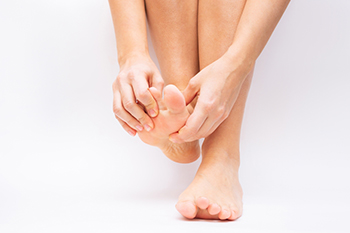
The most common form of toe pain occurs in the big toe. This joint takes a lot of abuse, as it absorbs most of the body weight with each step you take. The two main big toe complaints are gout and bunions. Less frequent causes are turf toe, and ingrown toenails. Toe pain to the smaller toes is most often caused by hammertoes and claw toes. Gout is an inflammatory disease that attacks the joints, causing redness, swelling and extreme pain. It is connected to a buildup of uric acid that crystalizes and induces pain. Bunions are a deformity at the base of the big toe, usually passed on genetically but made worse by ill-fitting footwear. It causes the toe to push outward at the base and inward at the top. It can adversely affect the biomechanics of the foot, causing other foot problems. Turf toe is common to football and basketball players, and dancers, who frequently push off the ground and hyper-extend their big toe. Ingrown toenails develop when the nail grows into the nailbed. Pressure from tight shoes can irritate the area, causing pain. Hammertoe and claw toe are painful deformities that affect the joints, tendons and soft tissues of the smaller toes. For help with any toe pain conditions you may be experiencing, it is suggested that you consult with a podiatrist.
Toe pain can disrupt your daily activities. If you have any concerns, contact one of our podiatrists of Boca Raton Podiatry . Our doctors can provide the care you need to keep you pain-free and on your feet.
What Causes Toe Pain?
Most severe toe pain is caused due to a sports injury, trauma from dropping something heavy on the toe, or bumping into something rigid. Other problems can develop over time for various reasons.
Toe pain can be caused by one or more ailments. The most common include:
- Trauma
- Sports injury
- Wearing shoes that are too tight
- Arthritis
- Gout
- Corns and calluses
- Hammertoe
- Bunions
- Blisters
- Ingrown toenails
- Sprains
- Fractures (broken bones)
- Dislocations
When to See a Podiatrist
- Severe pain
- Persistent pain that lasts more than a week
- Signs of infection
- Continued swelling
- Pain that prevents walking
Diagnosis
In many cases the cause of toe pain is obvious, but in others, a podiatrist may want to use more advanced methods to determine the problem. These can range from simple visual inspections and sensation tests to X-rays and MRI scans. Prior medical history, family medical history, and any recent physical traumatic events will all be taken into consideration for a proper diagnosis.
Treatment
Treatments for toe pain and injuries vary and may include shoe inserts, padding, taping, medicines, injections, and in some cases, surgery. If you believe that you have broken a toe, please see a podiatrist as soon as possible.
If you have any questions please feel free to contact our office located in Boca Raton, FL . We offer the newest diagnostic tools and technology to treat your foot and ankle needs.
What is Freiberg’s Disease?

Despite the fact that Freiberg’s disease is a rare foot condition, it can still be helpful to learn more about the affliction in case you or a loved one develops it. Generally speaking, an individual who suffers from Freiberg’s disease has a fractured base of the metatarsal bones, located on the ball of the feet. This primarily affects the second and third metatarsal bones. There are multiple potential causes of Freiberg’s disease. First, the disease can be caused by excessive weight-bearing activities—such as jumping and running—that put extra strain on the ball of the feet. This can essentially lead to sustained trauma over time, ultimately resulting in Freiberg’s disease. If you have Freiberg's disease, you might notice a sense of pain and discomfort around the affected area. It is also common for someone who suffers from this condition to experience swelling and bruising of some sort on and around the feet. Rare foot conditions certainly will not affect everyone. However, it is possible that you or someone you know could be affected. If you think that you could have Freiberg’s disease, reach out to a podiatrist who will be able to help you.
Some foot conditions may require additional professional care. If you have any concerns, contact one of our podiatrists of Boca Raton Podiatry . Our doctors can provide the care you need to keep you pain-free and on your feet.
Rare Foot Conditions
The majority of foot conditions are common and can be treated by a podiatrist. Standard diagnostic procedures are generally used to identify specific conditions and treatment can be rendered. A podiatrist also treats rare foot conditions which can be difficult to diagnose and may need extra attention and care.
There are many rare foot conditions that can affect children. Some of these can include:
- Freiberg’s disease
- Kohler’s disease
- Maffucci syndrome
Freiberg’s disease - This can be seen as a deterioration and flattening of a metatarsal bone that exists in the ball of the foot. It typically affects pre-teen and teenage girls, but can affect anyone at any age. Symptoms that can accompany this can be swelling, stiffness, and the patient may limp.
Kohler’s disease - This often targets the bone in the arch of the foot and affects younger boys. It can lead to an interruption of the blood supply which ultimately can lead to bone deterioration. The patient may limp or experience tenderness, swelling, and redness.
Maffucci syndrome - This affects the long bones in a child’s foot leading to the development of abnormal bone lesions. They are benign growths and typically develop in early childhood and the bones may be susceptible to breaking.
A podiatrist can properly diagnose and treat all types of rare foot conditions. If your child is affected by any of these symptoms or conditions, please don’t hesitate to call our office so the correct treatment method can begin.
If you have any questions please feel free to contact our office located in Boca Raton, FL . We offer the newest diagnostic tools and technology to treat your foot and ankle needs.
Broken Toe Treatment Options
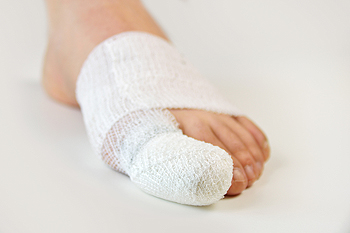
Many people who have endured a broken toe often treat it by using the buddy taping method. This is done by taping the affected toe to the toe next to it, and is often an effective method in providing the stability that is necessary to completely heal the toe. A broken toe can occur from a heavy object falling on it, or if it is jammed into a piece of furniture. If the fracture is severe, there may be a bone that protrudes through the skin, and immediate medical attention is needed. Part of the recovery process is to stay off of the foot as much as possible, in addition to limiting daily activities. The toe will most likely be swollen and bruised, and it will be painful to walk without limping. Some patients opt to use a walking boot, and this can be helpful in relieving some of the pressure on the affected toe. Larger shoes may need to be purchased that can accommodate the broken toe, and a splint may need to be worn, depending upon which toe is affected. If you have broken your toe, please speak with a podiatrist who can guide you toward the treatment that is correct for you.
Broken toes may cause a lot of pain and should be treated as soon as possible. If you have any concerns about your feet, contact one of our podiatrists from Boca Raton Podiatry . Our doctors will treat your foot and ankle needs.
What Is a Broken Toe?
A broken toe occurs when one or more of the toe bones of the foot are broken after an injury. Injuries such as stubbing your toe or dropping a heavy object on it may cause a toe fracture.
Symptoms of a Broken Toe
- Swelling
- Pain (with/without wearing shoes)
- Stiffness
- Nail Injury
Although the injured toe should be monitored daily, it is especially important to have a podiatrist look at your toe if you have severe symptoms. Some of these symptoms include worsening or new pain that is not relieved with medication, sores, redness, or open wounds near the toe.
If you have any questions, please feel free to contact our office located in Boca Raton, FL . We offer the newest diagnostic and treatment technologies for all your foot care needs.
What to Know About a Broken Toe
The forefoot is composed of five metatarsal bones and fourteen phalanges. Each toe has three phalanges except for the big toe which only has two. Our toes play an essential role to the walking process, which is why a broken toe could seriously disrupt one’s ability to move around. Toe fractures are common and can be very painful. Fortunately, these injuries rarely require surgery and usually heal with rest and a change in activity.
Broken toes typically result from a traumatic event such as falling, stubbing the toe, or dropping something on the toe. Traumatic toe fractures may be categorized as either minor or severe fractures. At times, one may hear a “pop” or “crack” sound when the bone breaks. Common symptoms of a traumatic toe fracture include pain, throbbing, bruising, swelling, and redness.
Another type of toe fractures is a stress fracture. These injuries usually appear in the form of small hairline breaks on the bone. Stress fractures develop after repetitive activity instead of a single injury. Stress fractures occur when the muscles in the bone become too weak to absorb impact. Consequently, the toe bone becomes vulnerable to any pressure and impact it endures. Symptoms for a stress fracture in the toe include swelling without bruising, tenderness to the touch, pain that goes away with rest, and pain after walking or running.
If you suspect that you have a broken toe, you should make an appointment with your podiatrist. He or she will likely diagnose you by performing a physical exam and an X-ray. Treatment for a broken toe may include the R.I.C.E. method, buddy taping, surgery, or antibiotics. The R.I.C.E. method (Rest, Ice, Compression, and Elevation) is a common treatment method for many injuries because it decreases pain. Buddy tapping involves wrapping the injured toe next to an adjacent toe to keep it supported and protected. These two methods have proven to be effective in the healing process for toe fractures. The estimated healing time for a broken toe is approximately four to six weeks. If the injury becomes infected or requires surgery, the estimated healing time may take eight weeks or more.
Why Is Your Ankle Feeling Wobbly and Painful?
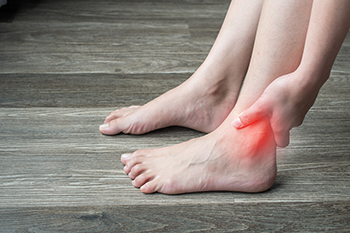 If you have suffered an ankle sprain that has not healed properly, and it has left your ankle ligaments overly loose, you are most likely experiencing ankle instability. A podiatrist will typically diagnose you with ankle instability if you are still experiencing weakness and laxity 6 months after an ankle sprain, or if you have suffered multiple ankle sprains. This is a common occurrence when the initial ankle sprain was not treated satisfactorily, which would have prevented it from healing properly. Ankle instability can also cause pain and tenderness, swelling and discomfort, and cause your ankle to repeatedly “give way.” Ankle instability that goes untreated may lead to chronic ankle instability, and even osteoarthritis in worst case scenarios. If you have had an ankle sprain in the past, and your ankle feels wobbly, weak, painful, or tender, there are treatments to help. It is suggested you start by having a podiatrist examine you and diagnose your condition.
If you have suffered an ankle sprain that has not healed properly, and it has left your ankle ligaments overly loose, you are most likely experiencing ankle instability. A podiatrist will typically diagnose you with ankle instability if you are still experiencing weakness and laxity 6 months after an ankle sprain, or if you have suffered multiple ankle sprains. This is a common occurrence when the initial ankle sprain was not treated satisfactorily, which would have prevented it from healing properly. Ankle instability can also cause pain and tenderness, swelling and discomfort, and cause your ankle to repeatedly “give way.” Ankle instability that goes untreated may lead to chronic ankle instability, and even osteoarthritis in worst case scenarios. If you have had an ankle sprain in the past, and your ankle feels wobbly, weak, painful, or tender, there are treatments to help. It is suggested you start by having a podiatrist examine you and diagnose your condition.
Ankle pain can have many different causes and the pain may potentially be serious. If you have ankle pain, consult with one of our podiatrists from Boca Raton Podiatry . Our doctors will assess your condition and provide you with quality foot and ankle treatment.
Ankle pain is any condition that causes pain in the ankle. Due to the fact that the ankle consists of tendons, muscles, bones, and ligaments, ankle pain can come from a number of different conditions.
Causes
The most common causes of ankle pain include:
- Types of arthritis (rheumatoid, osteoarthritis, and gout)
- Ankle sprains
- Broken ankles
- Achilles tendinitis
- Achilles tendon rupture
- Stress fractures
- Tarsal tunnel syndrome
- Plantar fasciitis
Symptoms
Symptoms of ankle injury vary based upon the condition. Pain may include general pain and discomfort, swelling, aching, redness, bruising, burning or stabbing sensations, and/or loss of sensation.
Diagnosis
Due to the wide variety of potential causes of ankle pain, podiatrists will utilize a number of different methods to properly diagnose ankle pain. This can include asking for personal and family medical histories and of any recent injuries. Further diagnosis may include sensation tests, a physical examination, and potentially x-rays or other imaging tests.
Treatment
Just as the range of causes varies widely, so do treatments. Some more common treatments are rest, ice packs, keeping pressure off the foot, orthotics and braces, medication for inflammation and pain, and surgery.
If you have any questions, please feel free to contact our office located in Boca Raton, FL . We offer the newest diagnostic and treatment technologies for all your foot care needs.




